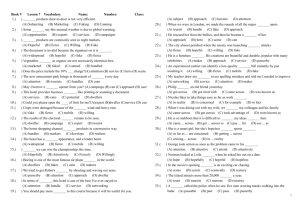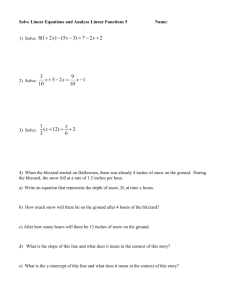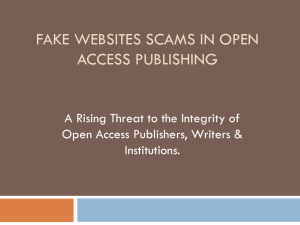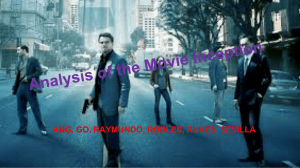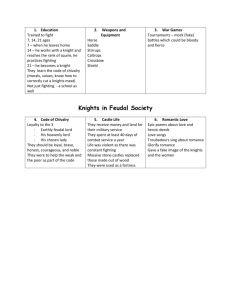Word Document
advertisement
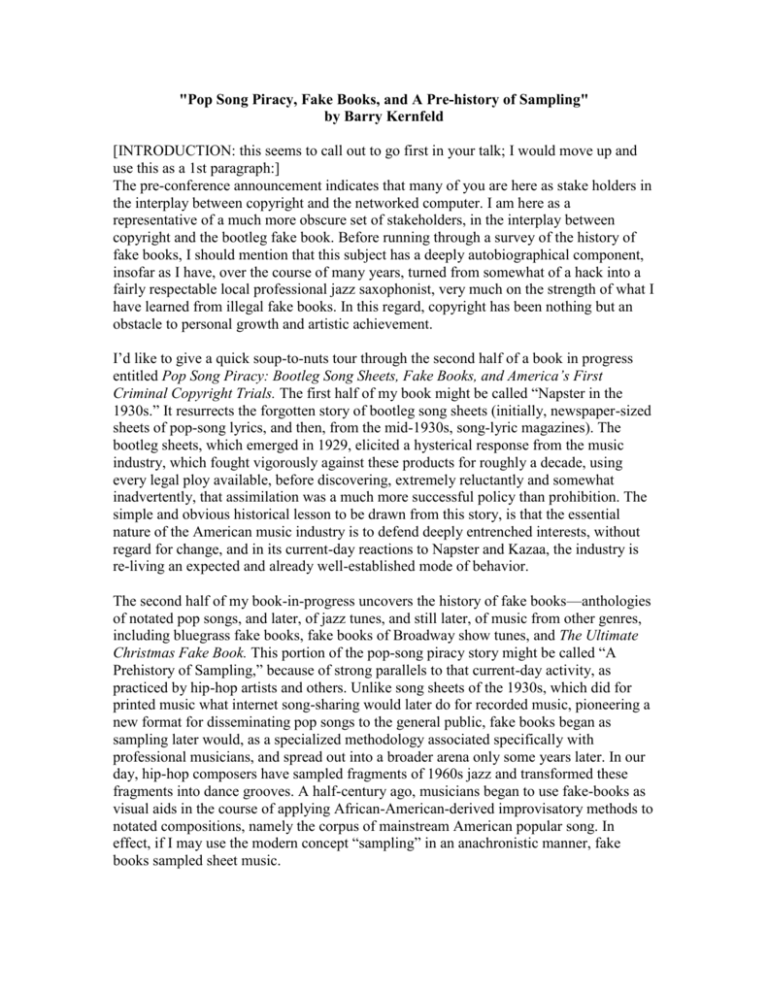
"Pop Song Piracy, Fake Books, and A Pre-history of Sampling" by Barry Kernfeld [INTRODUCTION: this seems to call out to go first in your talk; I would move up and use this as a 1st paragraph:] The pre-conference announcement indicates that many of you are here as stake holders in the interplay between copyright and the networked computer. I am here as a representative of a much more obscure set of stakeholders, in the interplay between copyright and the bootleg fake book. Before running through a survey of the history of fake books, I should mention that this subject has a deeply autobiographical component, insofar as I have, over the course of many years, turned from somewhat of a hack into a fairly respectable local professional jazz saxophonist, very much on the strength of what I have learned from illegal fake books. In this regard, copyright has been nothing but an obstacle to personal growth and artistic achievement. I’d like to give a quick soup-to-nuts tour through the second half of a book in progress entitled Pop Song Piracy: Bootleg Song Sheets, Fake Books, and America’s First Criminal Copyright Trials. The first half of my book might be called “Napster in the 1930s.” It resurrects the forgotten story of bootleg song sheets (initially, newspaper-sized sheets of pop-song lyrics, and then, from the mid-1930s, song-lyric magazines). The bootleg sheets, which emerged in 1929, elicited a hysterical response from the music industry, which fought vigorously against these products for roughly a decade, using every legal ploy available, before discovering, extremely reluctantly and somewhat inadvertently, that assimilation was a much more successful policy than prohibition. The simple and obvious historical lesson to be drawn from this story, is that the essential nature of the American music industry is to defend deeply entrenched interests, without regard for change, and in its current-day reactions to Napster and Kazaa, the industry is re-living an expected and already well-established mode of behavior. The second half of my book-in-progress uncovers the history of fake books—anthologies of notated pop songs, and later, of jazz tunes, and still later, of music from other genres, including bluegrass fake books, fake books of Broadway show tunes, and The Ultimate Christmas Fake Book. This portion of the pop-song piracy story might be called “A Prehistory of Sampling,” because of strong parallels to that current-day activity, as practiced by hip-hop artists and others. Unlike song sheets of the 1930s, which did for printed music what internet song-sharing would later do for recorded music, pioneering a new format for disseminating pop songs to the general public, fake books began as sampling later would, as a specialized methodology associated specifically with professional musicians, and spread out into a broader arena only some years later. In our day, hip-hop composers have sampled fragments of 1960s jazz and transformed these fragments into dance grooves. A half-century ago, musicians began to use fake-books as visual aids in the course of applying African-American-derived improvisatory methods to notated compositions, namely the corpus of mainstream American popular song. In effect, if I may use the modern concept “sampling” in an anachronistic manner, fake books sampled sheet music. In May 1942 George Goodwin, a radio station director, sent out the first monthly issue of 100 Tune-Dex cards. This was the era of 3- by 5-inch cards in American libraries, and Goodwin sought to create an analogous card catalogue for the music industry. As you can see in example 1, the front of each card gave the most familiar phrases of a pop-song melody, with lyrics below the melody, and chord symbols--shorthand guides to piano and guitar accompaniment--above the melody. The back of each card identified the copyright holder and the performing rights agency controlling the song’s licensing, and it gave references to piano and vocal sheet music, and perhaps also to orchestrations for dance bands or vocal groups. The Tune-Dex was a huge and immediate success, adopted industry-wide, in film, radio, recording, and advertising, for the day-to-day routine of operations involving programming or licensing. It ran to 25,000 cards and ended in 1963 only because illhealth forced Goodwin’s retirement. He died in 1965. As an adjunct to his principal promotional campaign, Goodwin promoted the Tune-Dex to professional entertainers in the emerging field of cocktail music. The advertisement “Which of these Worries are Yours,” example 2, appealed to a feeling of musical inadequacy. If a customer had a request, and the musician didn’t know, or couldn’t remember a song, the Tune-Dex could come to the rescue. It was, in effect, a twist on the old cliché, “If you hum a few bars, I can fake it.” Instead, with a Tune-Dex card at hand, “If I read a few bars, I can fake it.” But Goodwin was wrong about the utility of his design. A card catalogue was a handy thing to have sitting in a radio studio or an ad agency office, but no-one in his right mind would bring a card catalogue to a cocktail lounge. And having a couple thousand loose index cards was probably even more unwieldy and disastrous than sorting through countless loose full-size pages of promotional copies of sheet music or orchestrations (the “pros” and “orks” in Goodwin’s ad). What musicians needed was a bound collection of Tune-Dex cards organized by title, by songwriter, or by dance category. A fake book. The music publishing industry refused to authorize such a book, asserting that it would undermine sheet music sales. Gangsters stepped into the gap, filling a new niche in our musical economy. The first bootleg fake books, photostat collections of Tune-Dex cards, were published in 1949. A Down Beat magazine article from 1951, example 3, refers to an FBI investigation which eventually ran through the 1960s and led to two full-blown trials for criminal copyright infringement in Federal District Court in Manhattan. In both instances, the defendants were found guilty, but they received no jail sentences, and the minimum fines allowed by law. At the latter trial, Judge J. Weinfeld had this to say: “Assuming, as the defendants allege, that ‘fake books’ have been accepted by the music industry without opposition, we have not yet reached the point, at least in this court’s view, where an industry custom and practice serves to repeal criminal laws.” This declaration sounded forceful and righteous—the law prevails—but it turned out to be hot air, really. Judge Weinfeld was wrong and had it backwards: in any meaningful, longstanding, widespread sense, custom and practice held sway over the law. The law had attempted to express a prohibition, but that prohibition had been repeatedly ignored, and hereafter it would be permanently ignored. To my knowledge, there have been no further federal trials surrounding bootleg fake books. These books are still disapproved, and available only surreptitiously, but by the late 1960s sheet music was becoming an antiquarian item, and any allegation that bootleg fake-book sales were cutting into legitimate sheet-music sales would have to be tempered by the fact that both domains were insignificant in the context of the emerging arenas of record and movie piracy. In the mid-1970s, the music industry began to put out legitimate, copyrighted collections of pop-song fake books. Almost immediately, bootleg pop-song fake books faded away. What a surprise. Prohibition failed. Assimilation worked. But no sooner did the music industry learn its lesson, after a quarter-century of wrong-headedness in the realm of pop song, than the whole ball game shifted to another field and started up all over again, in the realm of jazz. During the academic year 1974 - 75, two students at the Berklee College of Music in Boston created a bootleg fake book called The Real Book, because it endeavored to notate what professional jazz musicians would really play, in contrast to the simplified versions typically given out on sheet music and reproduced in earlier generations of fake books. Steve Swallow, a professional bassist teaching at Berklee at that time, reported that their intention was “to make a book that contained a hipper repertoire, more contemporary repertoire. They thought about what would be involved in doing it legally, paying royalties, and couldn’t see the possibility of setting up a mechanism for doing that. They didn’t have the time, nor did they have any money to invest.” One of the book’s creators was a student of guitarist Pat Metheny. Metheny had this to say: “Honestly, at the time, neither I nor probably anyone else considered that The Real Book would ever have much of a life beyond the few interested parties who were around the scene. No one knew that it would ever become an almost biblical reference work to young musicians.” Swallow described the book’s impact at its inception: “In order to walk to the rooms where I taught my ensembles in Berklee, I had to run the gamet of dozens of rehearsal rooms, down a corridor. On either side of this corridor I would hear twenty or thirty . . . guys playing standards and a month after The Real Book was published, all of a sudden I was hearing the right changes to tunes that had been butchered. It used to be a hilarious journey down the corridor, to hear the flagrant harmonic violations just spewing out of these rooms. It’s not to say that all of a sudden everything sounded great and it was Bill Evans at every turn, but there was a huge improvement.” I asked: How do you think that that weighed against the idea that things became fossilized? Steve Swallow replied: I think that’s an unfortunate aspect of The Real Book’s rise to prominence. These particular 400 tunes were canonized at the expense, obviously, of what they left out, and they left out plenty. But I’m not complaining too loudly, because to a large extent I think they were accurately reflecting what college jazz people were listening to at that time, and were skimming the cream of that repertoire.” Pat Metheny expanded on this thought: “It was the first book that also reflected the more ecumenical nature of jazz and the jazz world of that time, and in this sense it is also an interesting time capsule. This was a fertile period where suddenly there were many young musicians who felt very comfortable with a vast array of harmonic vocabularies (from standards to Joe Henderson and beyond) and were at home with modern rhythmic styles as well as even things that looked to the rock music of the time as sources of material. In this sense, I feel The Real Book has had an enormous impact. It has certainly caused a few generations of players now to have to develop skills that were rare at that time—only the very best players of that era would be able to go pretty much from start to finish in that book and be able to generally deal with the intrinsic musical requirements that such a book would demand. Nowadays, it is pretty common; and in fact, sort of required.” The Real Book was an immense underground success. Today, despite the subsequent appearance of numerous legitimate, authorized, copyrighted rivals, this bootleg jazz fake book continues to be used extensively throughout the world, because its combination of tasteful repertory and idiomatic representation remains unmatched. It is a story of happenstance, of a casual student effort transforming itself into a creative act of immense significance, and surviving only because, by this time, in the mid-1970s, bootleg fake books were flying beneath the radar, as far as Federal criminal prosecution was concerned. Metheny said: “It still is kind of unbelievable to me when I see it almost 30 years later now, on bandstands from Kiev to Bali, knowing it’s history like I do. Believe me, no one involved would have ever imagined it.” How many other such creative actions has the Copyright Act intimidated and suppressed, in realms that are flying within radar coverage? And here we are, in 2003, with shady characters still delivering The Real Book to music stores from car trunks, and just about every aspiring jazz musician still lining up to buy a copy under the counter. Will the music industry ever unlearn its reactionary patterns of behavior? I doubt it.
